Golfer’s Elbow: Physiotherapy Treatment, Exercise
Table of Contents
What is a Golfer’s Elbow?
Golfer’s elbow, also known as medial epicondylitis, is a common condition characterized by pain and inflammation on the inner side of the elbow.
A golfer’s elbow is in some ways similar to a tennis elbow, which affects the outside at the lateral epicondyle. The anterior forearm contains several muscles which flex the digits of the hand, and flexing and pronate the wrist.
The tendons of these muscles come together in a common tendinous sheath, which originates from the medial epicondyle of the humerus at the elbow joint. In response to a minor injury, or sometimes for no obvious reason at all, this point of insertion becomes inflamed, which is called medial epicondylitis.
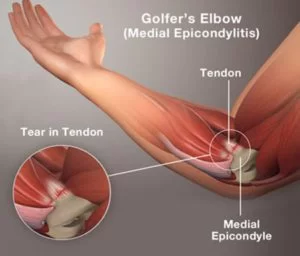
Causes of Golfer’s Elbow:
The condition is called golfer’s elbow because in making a golf swing this tendon is stressed, especially if a non-overlapping (baseball style) grip is used. But, this condition doesn’t just affect golfers. Any repetitive hand, wrist, or forearm motions can lead to golfer’s elbow. Risky sports include tennis, bowling, and baseball — in fact, it’s sometimes called pitcher’s elbow.
The tendon of the wrist flexor muscles on the inside of the elbow becomes painful and inflamed at their attachment point on the inner elbow because of the overuse of the muscle.
In this condition, pain at the medial epicondyle is aggravated by resisted wrist flexion and pronation, which is used to aid diagnosis.
Epicondylitis is much more common on the lateral side of the elbow (tennis elbow), rather than the medial side.
Signs & Symptoms
The main symptoms are –
- Elbow pain
- tenderness on the medial epicondyle
- problem in gripping
- general weakness in the wrist and
- Inflammation of the flexor tendons.
Diagnosis
The diagnosis of medial epicondylitis is based on local pain at the elbow. Tenderness and pain with palpation on the distal and anterior of the medial epicondyle. An increase in pain at the medial epicondyle with resisted isometric flexion, repetitive flexion, and pronation of the wrist can also be examined.
In particular, the Golfer’s Elbow Test is useful.
In this, the patient should be seated or standing and should have his/her fingers flexed in a fist position. The examiner palpates the medial epicondyle with one hand and grasps the patient’s wrist with his/her other hand. The examiner then passively supinates the forearm and extends the elbow and wrist. A positive test would be a complaint of pain or discomfort along the medial aspect of the elbow in the region of the medial epicondyle.
Golfer’s elbow Treatment:
Treatment for golfer’s elbow typically involves a combination of rest, icing, and the use of nonsteroidal anti-inflammatory drugs (NSAIDs) to reduce pain and inflammation. Physical therapy exercises are often recommended to strengthen the forearm muscles and improve flexibility. In more severe cases, a brace or splint may be used to immobilize the elbow and allow for healing.
Non-specific treatments include:
Non-steroidal anti-inflammatory drugs (NSAIDs): ibuprofen, naproxen, or aspirin
Heat or ice therapy.
A counter-force brace or “elbow strap” reduces strain at the elbow epicondyle, limits pain provocation, and protects against further damage.
Surgical Management:
When conservative management fails and there is persistent pain after 6 to 12 months and all other pathologies are considered, surgical treatment must be considered. Surgery for the failure of conservative treatment relieves pain, restores strength, and allows a return to the previous level of daily living and sports activity. The following surgical procedures are preferred:
- Minimally invasive method
- Ultrasound-guided removal of scar tissue in the region of the tendon pain
- Corticosteroid injections.
Physiotherapy Treatment:
- Rest: Put your golf game or other repetitive activities on hold until the pain is gone. If you return to activity too soon, you may make it worse.
- For pain relief:
IFT (interferential therapy)
TENS ( Transcutaneous Electrical Nerve Stimulation )
- Ice: On the affected area. Apply ice packs to your elbow for 15 to 20 minutes at a time, three to four times a day for several days. To protect your skin, wrap the ice packs in a thin towel. It might help to massage the inner elbow with ice for five minutes at a time, two to three times a day.
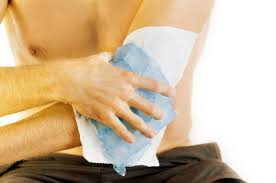
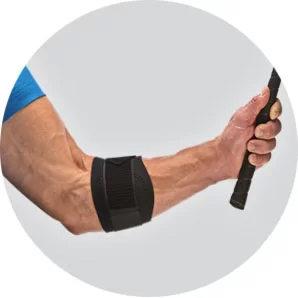
Use a brace:
Your doctor might recommend that you wear a counterforce brace on your affected arm, which might reduce tendon and muscle strain.
Stretching and Strengthening exercise:
Your doctor may suggest stretching and strengthening exercises. A type of strengthening (eccentric) that lengthens the tendon of the wrist extensor muscles has been shown to be particularly effective in treating chronic tendon irritation.
Exercises are like-
- Resisted exercise for elbow flexion and pronation
- Strengthening exercise for wrist flexion with dumbbell
- Wrist flexor stretching
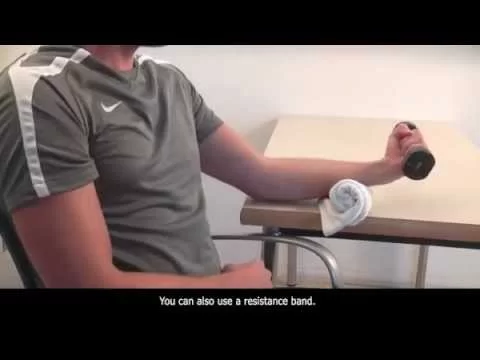
rehabilitation exercise
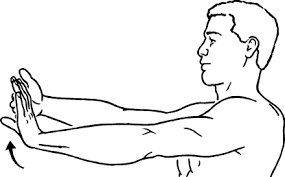
Gradually return to your usual activities. When your pain is gone, practice the arm motions of your sport or activity. Review your golf or tennis swing with an instructor and make adjustments if needed.
How to Prevent Golfer’s Elbow?
To prevent Golfer’s elbow following tips are useful for you:
- Strengthen your forearm muscles: Use light weights Dumbells or squeeze a ball. Strengthening exercises keep your muscles absorbing the energy of sudden physical stress during playing sports or performing day-to-day activities.
- Warm-up before your Sports or activity: Simple active wrist movement with Walk for a few minutes to warm up your muscles. Then perform light stretches before you start your game or activity to reduce the risk of injury.
- Fix your form: When you start your sport, check your form to avoid overload on your elbow muscles.
- Use the right equipment: If you’re playing with older golfing irons, change to lightweight graphite clubs. If you play tennis, make sure your racket is lightweight and suits you. A racket with an improper grip or a heavy head may increase the risk of elbow pain.
- Lift properly: When you lift such as free weights, keep sure that your wrist grip is firm and stable to reduce the force on your elbow.
- Take enough rest in between activities or Sport: Rest keeps your muscles become relaxed and avoid overuse of your elbow. When you feel fatigued or have signs of elbow pain, take a break.
- Maintain good overall fitness: Engage in regular physical exercise to maintain overall fitness and strength. This can help improve your endurance and reduce the risk of injury. Include exercises that target the muscles of your arms, shoulders, and core to provide support and stability during your golf swing.
Remember, these preventive measures may reduce the risk of a golfer’s elbow, but they do not guarantee complete prevention. If you’re already experiencing symptoms, it’s best to consult with a healthcare professional for an accurate diagnosis and appropriate treatment plan.
Summary:
Golfer’s elbow, also known as medial epicondylitis, is a condition characterized by pain and inflammation on the inner side of the elbow. It is a common overuse injury that typically affects individuals who engage in repetitive motions, such as golfers, tennis players, and those involved in manual labor or certain sports activities.
While most cases of golfer’s elbow can be successfully treated with conservative measures, in rare instances, surgical intervention may be necessary to repair severely damaged tendons or remove scar tissue.
It’s essential to consult with a healthcare professional for an accurate diagnosis and appropriate treatment plan tailored to individual needs.
FAQs
To fix a golfer’s elbow:
Modification of activity.
injections of corticosteroids.
Extracorporeal shock wave treatment delivers energy waves to injured soft tissues in the elbow under the guidance of ultrasonography.
Icicing.
Painkillers or anti-inflammatory drugs.
Physical therapy Treatment and range-of-motion exercises.
Medial epicondylitis, another name for golfer’s elbow, is caused by injury to the tendons and muscles that govern your fingers and wrist. Usually, excessive or recurrent stress—especially from strong wrist and finger motions—is the cause of the injury.
According to recent studies, injury to a particular forearm muscle is frequently the cause of golfer’s elbow. When the elbow is bent, the flexor carpi radialis (FCR) and pronator teres (PT) muscles assist in stabilizing the wrist.
Yes, golfer’s elbow can fully heal with appropriate treatment, which may include rest, ice, anti-inflammatory medications, physical therapy, and in some cases, bracing. Severe cases may require more prolonged rehabilitation or, in rare instances, surgery. Early diagnosis and proper management increase the likelihood of a full recovery.
The best option to cure golfers elbow
Rest: Put off playing golf or engaging in any other repetitive activity until the pain subsides.
Ice the impacted region. For many days, apply ice packs to your elbow three or four times a day for 15 to 20 minutes at a time.
Attach a brace.
Extend and strengthen the impacted area.

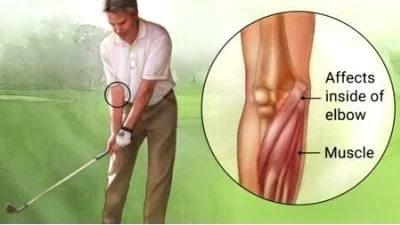

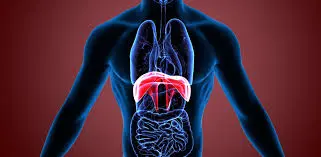
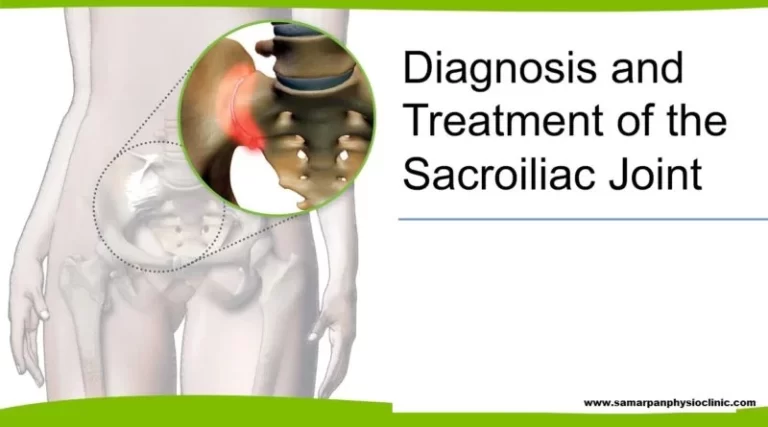
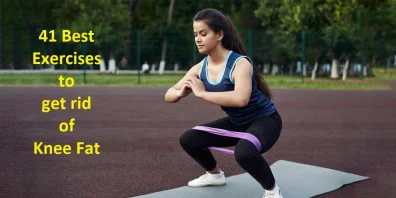
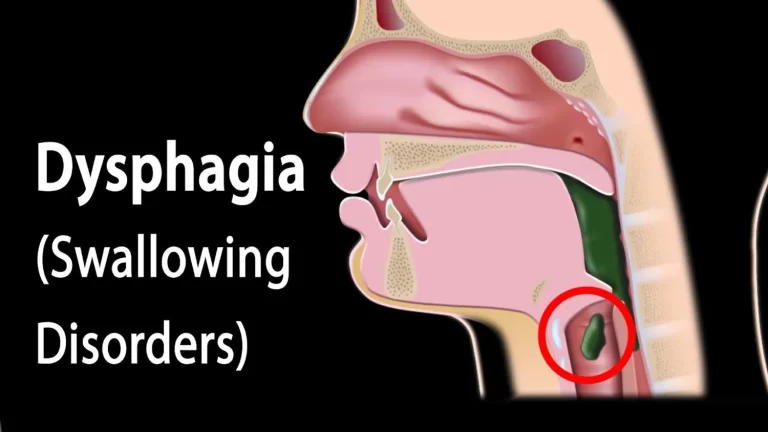
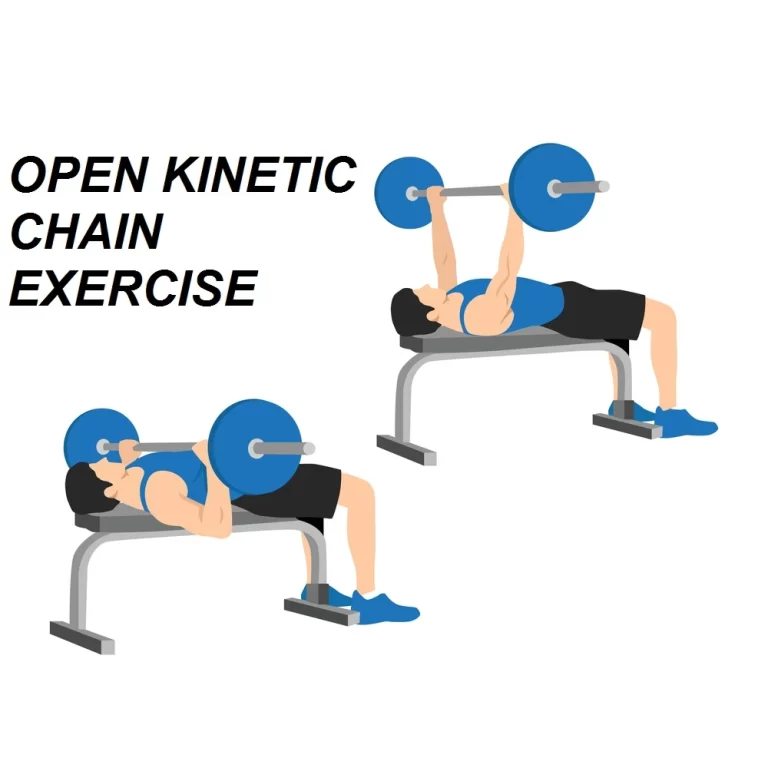
5 Comments